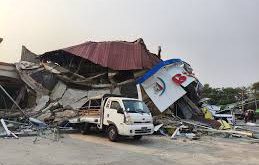March 19, 2025 — In a country where education remains a battleground, UNICEF is constructing 165 schools across Afghanistan, offering a beacon of hope for thousands of children, even as the Taliban’s sweeping restrictions continue to bar girls above sixth grade from attending class for a fourth consecutive year.
With support from the Government of Japan, UNICEF, in partnership with the United Nations Development Program (UNDP), is undertaking one of the most ambitious school construction projects in Afghanistan’s recent history. The initiative spans the East, South, and Central regions of the country, providing more than 33,000 children—half of them girls—with access to safe and well-equipped classrooms.
Each school is designed to provide a secure learning environment, featuring solar-powered lighting, separate latrine blocks, handwashing stations, and drilled water wells to ensure access to clean drinking water. High boundary walls—an essential requirement for families hesitant to send their daughters to school—offer a measure of security in an environment where education for girls remains a highly contested issue.
Yet even as these schools rise from the dust, the question of who will be allowed to attend them looms large. Since seizing power in August 2021, the Taliban has systematically rolled back women’s rights, imposing a series of harsh restrictions that have effectively erased Afghan women from public life. Chief among these policies is the ban on secondary and higher education for girls, which has now entered its fourth consecutive year.
For many Afghan children, particularly those in rural areas, the new schools represent their first opportunity to sit inside a proper classroom. Before construction, students often studied outdoors—sitting on the ground under makeshift tents or beneath trees, braving harsh winds, dust storms, and the punishing summer heat. The move into a structured learning environment has been nothing short of transformative for both students and teachers.
Afghanistan’s education crisis is severe. An estimated seven million children remain out of school due to economic hardship, displacement, and government-imposed restrictions. Sixty percent of them are girls. Nationwide, at least half of all public schools lack adequate classroom space, while 58 percent have no access to drinking water or proper sanitation facilities. Fewer than half of the country’s schools have boundary walls, a key factor in determining whether families feel safe sending their daughters to class.
UNICEF’s initiative is not just about infrastructure—it is a direct challenge to the forces seeking to suppress education. But even as international organizations push forward, the reality remains bleak: without policy changes from the Taliban, these schools may remain half-empty, their desks and blackboards waiting for the students who are barred from attending.
For now, Afghan girls above the sixth grade continue to wait, their futures uncertain, their ambitions held hostage by an unrelenting regime. Whether the walls of these newly built schools will one day shelter their dreams remains an open question—one that the world, and Afghanistan’s rulers, must answer.
 Afghanistan Times
Afghanistan Times




